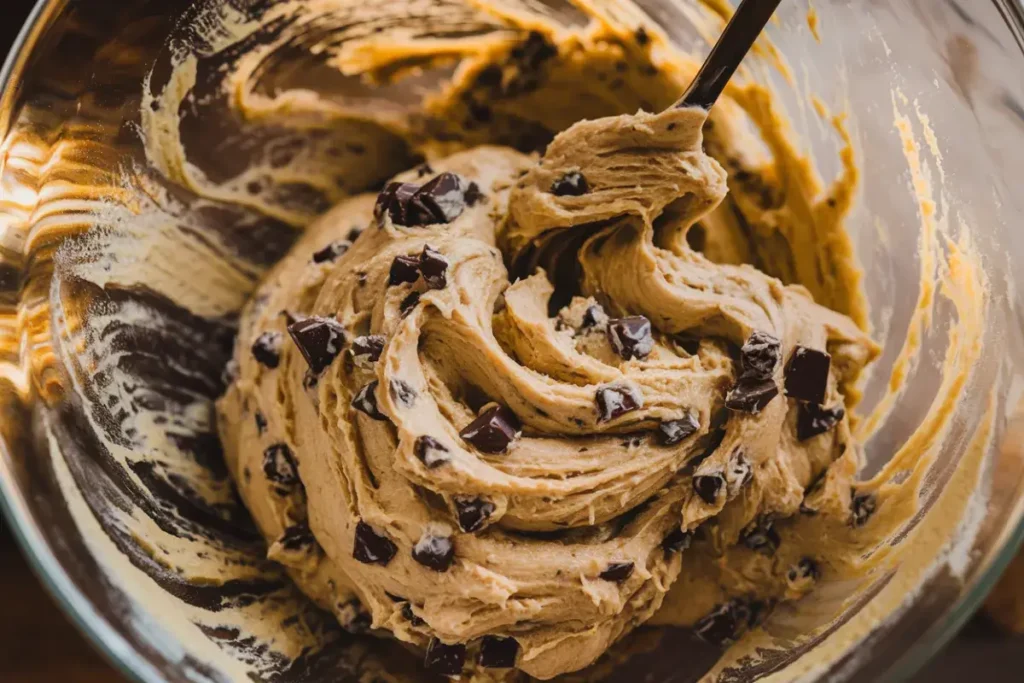Who doesn’t love cookie dough? It’s one of those indulgent treats we can’t resist. But what if I told you that there’s a way to enjoy it with less guilt? Enter cottage cheese cookie dough, a high-protein, low-fat alternative to traditional cookie dough that still satisfies your sweet tooth.
Why Choose Cottage Cheese Cookie Dough?
Cottage cheese might not be the first ingredient that comes to mind when you think of cookie dough, but it’s actually a game-changer. This recipe provides a nutritional boost, making your dessert not only delicious but also packed with benefits. Here’s why:
- High in Protein: Cottage cheese is naturally rich in protein, which helps you feel fuller for longer.
- Lower in Fat: Compared to the butter and oils found in traditional cookie dough, cottage cheese offers a low-fat alternative.
- Versatile and Easy to Use: It blends well into the dough, creating a creamy texture without overpowering the flavor.
When you substitute cottage cheese for some of the butter or eggs, you’re not just cutting calories — you’re enhancing the nutritional profile. For more about the nutritional benefits of cottage cheese, check out this resource.
Health Benefits of Cottage Cheese in Cookie Dough
We’re all looking for healthier dessert options, and this healthy treat fits the bill perfectly. Let’s break down some of the key health benefits:
- Rich in Protein: As mentioned, cottage cheese is a great source of protein, which makes this cookie dough a smart choice if you’re on a high-protein diet.
- Lower in Calories: Compared to traditional cookie dough, which often relies on heavy fats like butter or oil, cottage cheese helps cut down on overall calorie intake. To learn more about how cottage cheese can replace ingredients in baking, check out this guide.
- Low-Carb Friendly: If you’re following a low-carb or ketogenic diet, cottage cheese is a great fit. It contains fewer carbs than flour-based dough, especially if you use low-carb sweeteners.
To see how cottage cheese can work well in baking, this guide on incorporating cottage cheese in baking offers some helpful insights.
Cottage Cheese Cookie Dough Recipe
Let’s get to the heart of the matter — how do you make this healthy treat? Below is a simple, easy-to-follow recipe that you can tweak based on your preferences.
Ingredients:
- 1 cup cottage cheese (preferably low-fat)
- 1/2 cup almond flour (or oat flour for a heartier texture)
- 1/3 cup natural sweetener (honey, maple syrup, or a sugar substitute like stevia)
- 1/2 tsp vanilla extract
- 1/4 cup dark chocolate chips (optional for a healthier twist)
- Pinch of salt
Directions:
- Blend the Cottage Cheese: Use a blender or food processor to puree the cottage cheese until it reaches a smooth consistency.
- Mix the Dry Ingredients: In a separate bowl, combine the flour, salt, and sweetener.
- Combine Wet and Dry Ingredients: Fold the pureed cottage cheese into the dry mixture. Stir until combined.
- Add Mix-ins: If desired, fold in dark chocolate chips, nuts, or dried fruit for added texture and flavor.
- Chill the Dough: Place the dough in the fridge for at least 30 minutes before eating or baking.
That’s it! You now have a delicious and healthier cookie dough that can be enjoyed raw (since it doesn’t contain raw eggs) or baked for a crispier treat.

Common Mistakes to Avoid When Making this Recipe
Even with such a simple recipe, there are a few things to keep in mind to ensure success:
- Overmixing: This can lead to a denser dough, making the final product less fluffy.
- Wrong Cottage Cheese Type: Always go for low-fat or full-fat cottage cheese depending on your preference, but avoid watery brands that might make the dough too runny.
- Moisture Issues: If your dough seems too wet, try adding a bit more flour or chilling the mixture longer to firm it up.
Variations and Customizations
The beauty of this cookie dough is its versatility. You can easily modify it to suit various dietary preferences and flavor profiles. Here are a few ideas:
- Vegan Option: Use vegan cottage cheese or silken tofu as a replacement.
- Gluten-Free: Swap out traditional flour for almond or coconut flour.
- Sugar-Free: Opt for natural sweeteners like stevia, monk fruit, or erythritol.
For extra indulgence, throw in some peanut butter, or add dried cranberries for a holiday twist!
How to Store Cottage Cheese Cookie Dough
One of the best parts of this high-protein option is that it can be easily stored for later use. Here are a few tips for keeping it fresh:
- Refrigeration: Store the dough in an airtight container and keep it in the fridge for up to one week.
- Freezing: If you want to prepare the dough in advance, you can freeze it in portioned dough balls. This makes for easy, on-demand baking. Simply pop the frozen dough into the oven for a freshly baked cookie whenever you want.
This flexibility makes this dough a great option for meal prepping or just keeping a healthy snack on hand for when a craving strikes.
Nutritional Information Breakdown
When it comes to cottage cheese cookie dough, it’s not just about taste; it’s also about the nutritional benefits you get compared to regular cookie dough. Here’s a detailed breakdown of what you can expect:
- Calories: Cottage cheese is relatively low in calories compared to traditional cookie dough ingredients like butter and sugar. On average, a serving of this dough can contain 30-40% fewer calories.
- Protein: A major advantage of using cottage cheese is its high protein content. While regular cookie dough contains minimal protein, this alternative can provide 10-12 grams of protein per serving.
- Fat Content: Regular cookie dough is typically loaded with fats from butter and oils. By using cottage cheese, you cut down the fat content considerably — around 5 grams per serving, compared to 15-20 grams in traditional dough.
- Carbohydrates: This dough is lower in carbs if you use almond or coconut flour and a sugar substitute. For a low-carb version, you can reduce the net carbs to 10 grams per serving or less.
This nutritional profile makes this healthy treat ideal for those on a diet looking for a healthier dessert that still satisfies cravings.
Cottage Cheese Cookie Dough for Special Diets
One of the best things about this recipe is its adaptability to various diets. Whether you’re following a keto plan, focusing on low-carb meals, or just looking for more protein in your snacks, cottage cheese cookie dough is a versatile option.
- Keto: By using almond flour and a keto-friendly sweetener like stevia, you can make this dough keto-compliant. The high-fat content of cottage cheese pairs perfectly with a low-carb flour, making it suitable for the ketogenic diet.
- Paleo: While cottage cheese itself may not fit the strict Paleo guidelines, you can adapt the recipe by substituting with cashew cream or almond butter for a Paleo twist.
- Low-Carb: If you’re cutting carbs, swap out regular flour with almond or coconut flour and opt for a sugar substitute like monk fruit or erythritol.
- High-Protein: As we’ve mentioned, cottage cheese is naturally rich in protein. This makes the dough a great post-workout snack, offering both taste and muscle-building nutrients.
The flexibility of cottage cheese cookie dough makes it perfect for those looking for a dessert that fits within specific dietary restrictions.
Using Cottage Cheese Cookie Dough in Other Desserts
While this high-protein option is amazing on its own, you can also incorporate it into other desserts for added variety. Here are a few ways to get creative:
- Ice Cream Mix-Ins: Fold chunks of chilled dough into your favorite ice cream for a healthy yet indulgent treat.
- Dessert Bars: Use the dough as a base for dessert bars by pressing it into a baking dish, then layering it with chocolate, caramel, or fruit. If you love combining cookies and brownies, you might want to try this perfect brookie recipe for an indulgent twist. Check it out here.
- Brownies: Add a scoop of cookie dough into the center of brownie batter before baking for a decadent, protein-packed surprise.
These fun ideas add versatility, giving you the freedom to use cottage cheese cookie dough in numerous ways.
Cottage Cheese Cookie Dough vs. Traditional Cookie Dough
Wondering how cottage cheese cookie dough stacks up against the classic version? Let’s break down some key differences:
- Taste: Traditional cookie dough is richer and more buttery, while cottage cheese cookie dough has a lighter, slightly tangy taste. However, with the right mix-ins (chocolate chips, nuts), it can be just as indulgent.
- Texture: Cottage cheese gives the dough a creamier texture, but it may not have the same firmness as butter-based dough. If you bake it, expect a softer cookie rather than a crisp one.
- Health Benefits: As mentioned earlier, this healthy treat is the clear winner when it comes to calories, fat, and protein. It’s a better option for those focusing on health without compromising taste.
Kid-Friendly Cottage Cheese Cookie Dough Recipes
If you want to make this healthier version appeal to kids, don’t worry — cottage cheese cookie dough is incredibly versatile. Here’s how you can make it fun:
- Shape it: Use cookie cutters to shape the dough into fun forms. Kids love the opportunity to get hands-on in the kitchen, and making shapes out of the dough is a great activity.
- Decorate: Let your kids decorate the dough with sprinkles, edible glitter, or small candies. You can even dye the dough with natural food coloring to make it colorful!
- Add Mix-Ins: Incorporate kid-friendly ingredients like mini chocolate chips, crushed pretzels, or raisins.
By adding a few creative touches, you can make this dough a snack that your kids will love — and you’ll feel good about them eating it!
Can You Eat Cottage Cheese Cookie Dough Raw?

One of the biggest perks of this high-protein option is that it’s safe to eat raw. Unlike traditional cookie dough, which often contains raw eggs that can pose a salmonella risk, this dough relies on cottage cheese and flour, so there’s no need to worry about harmful bacteria.
To be extra cautious, you can:
- Use heat-treated flour: While almond and coconut flours are typically safe to eat raw, you can opt for heat-treated flour if you’re using regular flour in your recipe.
- Store it properly: Keep the dough refrigerated if you’re not eating it right away to avoid any spoilage or bacterial growth.
This means you can enjoy this cookie dough straight from the bowl without any hesitation!
History and Evolution of Cottage Cheese in Baking
You might think of cottage cheese as a savory ingredient, often used in salads or as a side dish, but its history in baking goes way back. Cottage cheese has been used as a low-fat alternative to butter and cream in European baking for centuries. It became more popular in American desserts as health-conscious bakers began searching for ways to cut calories while maintaining a creamy texture.
Over the years, the rise in interest for high-protein, low-fat recipes has cemented cottage cheese’s place in both savory and sweet dishes.
Practical Tips for Baking with Cottage Cheese
If you’re planning to use cottage cheese in more of your baking, here are a few tips to keep in mind:
- Drain Excess Moisture: Cottage cheese can sometimes be too watery for baking. Draining it first will help you get the right consistency.
- Blend for Smoothness: Cottage cheese can have a slightly chunky texture, so blend it to ensure it mixes seamlessly into batters.
- Balance Flavors: Cottage cheese has a tangy undertone, so balance it with vanilla or a bit of extra sweetener in your recipes.
With these tips, you can incorporate cottage cheese into all kinds of baked goods beyond just cookie dough.
Conclusion: Why You Should Try Cottage Cheese Cookie Dough Today
If you’re on the hunt for a healthier, high-protein snack that doesn’t skimp on taste, this recipe is worth trying. It’s packed with nutrients, easy to make, and highly customizable to fit any diet or flavor preference. Whether you’re eating it raw, baking it into cookies, or using it in other desserts, this dough is a delicious option that you can feel good about indulging in.
FAQs
- Can you substitute cottage cheese for other ingredients in cookie dough?
Yes, you can use cottage cheese in place of butter or cream cheese to make your cookie dough healthier and lower in fat. - What type of cottage cheese works best for cookie dough?
Opt for low-fat or full-fat cottage cheese, but make sure it’s not too watery. Draining it can help maintain the right consistency. - How do you make cottage cheese cookie dough vegan?
You can substitute vegan cottage cheese or use silken tofu in place of regular cottage cheese for a plant-based version. - Can you freeze cottage cheese cookie dough?
Absolutely! You can freeze portioned dough balls for up to 3 months, making it easy to bake a fresh batch whenever the craving strikes. - Does cottage cheese cookie dough taste different from regular cookie dough?
Yes, the taste is slightly tangier due to the cottage cheese, but it’s still sweet and delicious, especially with mix-ins like chocolate chips.

